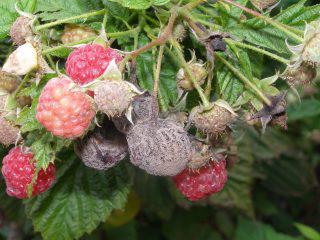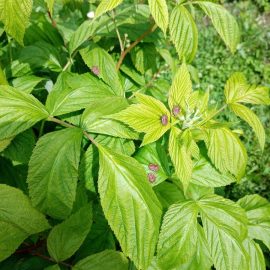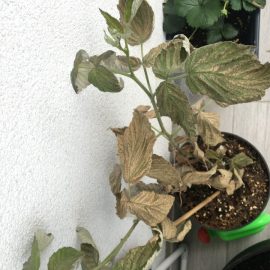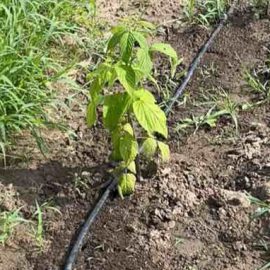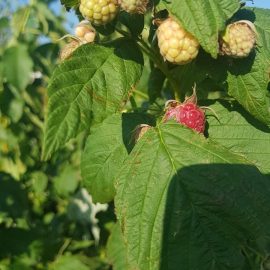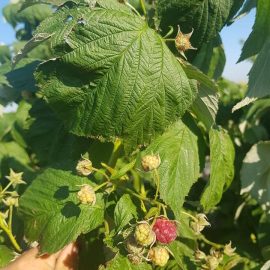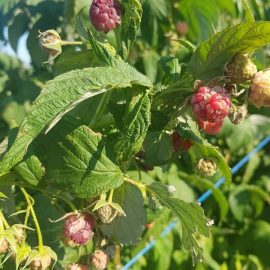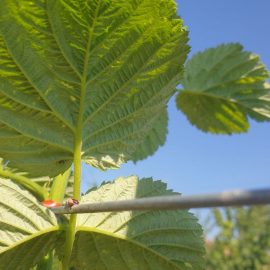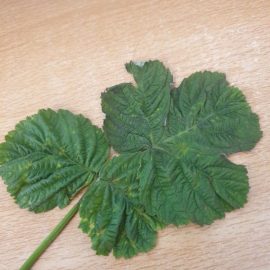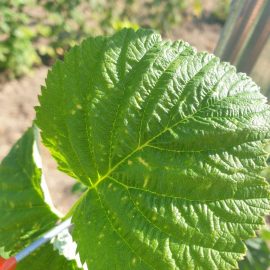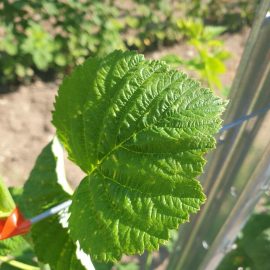Raspberry treatments, pest and disease control
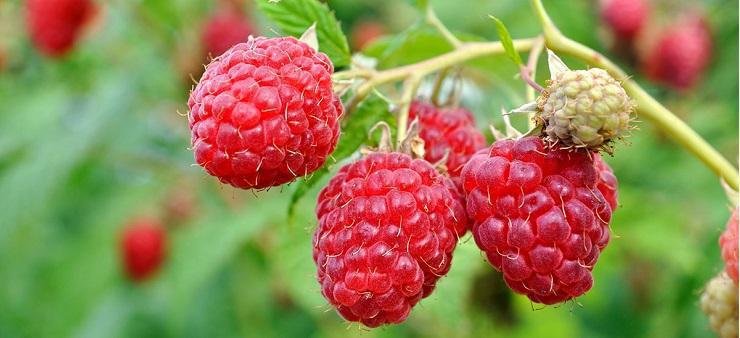
Raspberry (Rubus idaeus) is a fruit-bearing shrub that grows spontaneously in temperate countries. It grows as a bush, with creeping shoots and straight, arching stems. Raspberries are cultivated because of their fruit. Raspberry fruits have a specific aroma, being used in the food industry and pharmaceutical or cosmetic industries. The fruits are rich in organic acids, sugar, fragarine, vitamins (A, C, E, B1, B2, B5, B6), carotene, cyanine, salicylic acid, copper, calcium, iron, iodine, potassium, magnesium, and phosphorus.
The main diseases of raspberry shrubs
VIRUSES
Leaf spot mosaic of raspberry (Raspberry leaf mottle virus)
It is also known simply as ‘raspberry mosaic virus’ and it is a widespread disease in raspberry plantations. Small yellow or yellowish-brown spots, about 2 mm in size, appear on the leaves with an irregular outline. The spots spread quite rapidly and occupy the entire surface of the leaf. A strong deformation accompanies the discoloration of the leaf. Following the attack, the leaf no longer develops normally and fruit quality is affected. Plant growth stagnates and the affected raspberry plants can be seen from a distance due to the specific coloring. The virus is transmitted by vegetative propagation or by aphids and other insects.
Prevention and control measures:
- checking raspberry plants to detect affected ones;
- removing affected plants from the crop and burning them;
- applying insecticides to control the aphid population.
BACTERIOSIS
Crown gall (Agrobacterium tumefaciens)
The emergence of the disease is favored by temperatures between 22 and 30 degrees Celsius and atmospheric humidity of ca. 80%. The bacterium enters the plant through wounds caused by nematodes, hail, etc. Tumors of different shapes and sizes develop on the roots and stems. In the beginning, they are small, white, and soft, and later they become woody and brown. The cells that make up these tumors are large and deformed. The bacterium can survive in the soil for many years and is spread by water, dust, and agricultural tools. Moist and compacted soils, excess nitrogen fertilizers, the presence of nematodes, etc favor the disease. Light has an inhibitory effect.
Prevention and control measures:
- placing plants on light soils;
- using healthy seedlings;
- disinfecting tools and machinery;
- removing affected plants.
Fire blight (Erwinia amylovora)
The attack is visible on the shoots, flowers, and fruits. The leaves’ tips are brown, dry, and curl into a hook shape, and in conditions of high atmospheric humidity, bacterial exudate appears on the surface of the attacked tissues. Erwinia amylovora is spread by pollinators, wind, water droplets, birds, etc. The bacterium is resistant to high temperatures and can survive in areas protected from sunlight for up to 12 months. Over winter, the bacteria survive in the affected tissues (buds, bark, shoots).
Prevention and control measures:
- cutting and burning of affected branches down to healthy tissue;
- chemical treatments with specific fungicides, applied after each rain.
MYCOSIS
Spur blight of raspberry (Didymella applanata)
It is also known as the ‘spur canker of raspberry’, and it causes significant damage in rainy springs. Large, brownish-purple spots appear on the young shoots at the end of spring and the beginning of summer. Attacked branches dry out from the tip to the base, and the attacked bark peels off. The disease progresses, and small, blackish-brown spots appear on the surface of the attacked tissues, representing the fungus fructification. The attack on the leaves manifests itself as large, colorful spots that appear along the main veins. The axillary buds at the base of the leaves turn brown and dry out. The fungus spreads through vegetation via spores carried by rainwater and wind.
Prevention and control measures:
- using healthy planting material;
- weed control;
- improving air circulation by appropriate prunings;
- rational fertilization;
- removing and burning dry branches;
- chemical treatments with specific fungicides.
Raspberry leaf spot (Sphaerulina rubi)
This disease is widespread in many countries with temperate climates. Circular, greyish-white spots (3-4 mm in diameter) appear on the leaves, bordered by a brownish-purple ring. The spots expand, merge, and become brown in time, and the leaves fall prematurely. The fungus overwinters on the plant debris from the soil surface and spreads by spores during the growing season.
Prevention and control measures:
- burning of dried leaves and stems;
- improving air circulation by planting at recommended distances and by performing specific maintenance work (especially pruning);
- chemical treatments with specific fungicides.
Raspberry anthracnose (Elsinoe veneta)
It is also known as the ‘cane spot of raspberry’ or the ‘grey bark of raspberry’. The characteristic attack can be observed on the shoots: small, oval, reddish-purple spots. As the disease progresses, the spots turn greyish-white, and the tissues sink. Attacked fruits are deformed and rot. After the attack, the fructification capacity is weakened or inhibited, and in case of a strong attack, the plant dies. The fungus overwinters on the plant debris from the soil surface.
Prevention and control measures:
- burning of the attacked shoots and leaves;
- using certified and healthy genetic material;
- chemical treatments with specific fungicides.
Recommended products
-
You can find products on a different store
Change Store -
You can find products on a different store
Change Store -
You can find products on a different store
Change Store -
You can find products on a different store
Change Store -
You can find products on a different store
Change Store -
You can find products on a different store
Change Store -
You can find products on a different store
Change Store -
You can find products on a different store
Change Store -
You can find products on a different store
Change Store -
You can find products on a different store
Change Store -
You can find products on a different store
Change Store -
You can find products on a different store
Change Store -
You can find products on a different store
Change Store -
You can find products on a different store
Change Store -
You can find products on a different store
Change Store -
You can find products on a different store
Change Store -
You can find products on a different store
Change Store -
You can find products on a different store
Change Store -
You can find products on a different store
Change Store -
You can find products on a different store
Change Store -
You can find products on a different store
Change Store -
You can find products on a different store
Change Store -
You can find products on a different store
Change Store -
You can find products on a different store
Change Store
Rust of raspberry (Phragmidium rubi-idaei)
This disease occurs frequently in raspberry crops. The attack occurs mainly on the leaves, on the upper side as yellowish spots, where, on the lower side, the fungus fructifications form. The fungus fructifications consist of circular orange-yellow formations. Heavily affected leaves turn yellow and fall off. At the end of the summer, among the clusters of yellow summer spores, black resistance spores form.
Prevention and control measures:
- planting resistant raspberry varieties;
- burning the plant debris from the plantation;
- 2-3 treatments with specific fungicides during the vegetative season.
Recommended products
-
You can find products on a different store
Change Store -
You can find products on a different store
Change Store -
You can find products on a different store
Change Store -
You can find products on a different store
Change Store -
You can find products on a different store
Change Store -
You can find products on a different store
Change Store -
You can find products on a different store
Change Store -
You can find products on a different store
Change Store -
You can find products on a different store
Change Store -
You can find products on a different store
Change Store -
You can find products on a different store
Change Store -
You can find products on a different store
Change Store -
You can find products on a different store
Change Store -
You can find products on a different store
Change Store -
You can find products on a different store
Change Store -
You can find products on a different store
Change Store -
You can find products on a different store
Change Store -
You can find products on a different store
Change Store -
You can find products on a different store
Change Store -
You can find products on a different store
Change Store -
You can find products on a different store
Change Store -
You can find products on a different store
Change Store -
You can find products on a different store
Change Store -
You can find products on a different store
Change Store
Powdery mildew (Sphaerotheca macularis)
Symptoms of the attack can be seen on the shoots, leaves, and fruits, which are covered with a greyish-white fuzz. The margins of the leaves are twisted, and the attacked shoots remain thin, deform, become brown, and finally dry out. Young fruits become covered with the same powdery fuzz. They stop ripening and rot.
Prevention and control measures:
- planting resistant raspberry varieties;
- removing and burning the attacked shoots;
- chemical treatments with specific fungicides.
Recommended products
-
You can find products on a different store
Change Store -
You can find products on a different store
Change Store -
You can find products on a different store
Change Store -
You can find products on a different store
Change Store -
You can find products on a different store
Change Store -
You can find products on a different store
Change Store -
You can find products on a different store
Change Store -
You can find products on a different store
Change Store -
You can find products on a different store
Change Store -
You can find products on a different store
Change Store -
You can find products on a different store
Change Store -
You can find products on a different store
Change Store -
You can find products on a different store
Change Store -
You can find products on a different store
Change Store -
You can find products on a different store
Change Store -
You can find products on a different store
Change Store -
You can find products on a different store
Change Store -
You can find products on a different store
Change Store -
You can find products on a different store
Change Store -
You can find products on a different store
Change Store -
You can find products on a different store
Change Store -
You can find products on a different store
Change Store -
You can find products on a different store
Change Store -
You can find products on a different store
Change Store
Gray mold (Botrytis cinerea)
The emergence of the fungus is favored by high humidity, low air ventilation, and low light conditions. In rainy years, the damage caused by this fungus can affect up to 70-80% of the crop. The fungus lives on the plant debris from the soil surface, and its spores are transported to healthy plants by air drafts and water droplets. Specific symptoms can be observed on the aerial organs of the attacked shrub: some surfaces turn brown and become covered with a gray fuzz (representing the fungus fructifications). Then, the affected organs rot. The attack on the stems occurs in rainy years and is manifested by dark brown spots. The disease evolves rapidly and can destroy the fruits or it can spread to neighboring plants. Gray mold can have a severe impact on production, even after harvest.
Prevention and control measures:
- planting resistant raspberry varieties;
- respecting the recommended planting distances;
- collecting and burning plant debris from the plantation;
- 3-4 chemical treatments are recommended in the following phases: green bud phase, white bud phase, flowering phase, and first fruit formation phase.
Recommended products
-
You can find products on a different store
Change Store -
You can find products on a different store
Change Store -
You can find products on a different store
Change Store -
You can find products on a different store
Change Store -
You can find products on a different store
Change Store -
You can find products on a different store
Change Store -
You can find products on a different store
Change Store -
You can find products on a different store
Change Store -
You can find products on a different store
Change Store -
You can find products on a different store
Change Store -
You can find products on a different store
Change Store -
You can find products on a different store
Change Store -
You can find products on a different store
Change Store -
You can find products on a different store
Change Store -
You can find products on a different store
Change Store -
You can find products on a different store
Change Store -
You can find products on a different store
Change Store -
You can find products on a different store
Change Store -
You can find products on a different store
Change Store -
You can find products on a different store
Change Store -
You can find products on a different store
Change Store -
You can find products on a different store
Change Store -
You can find products on a different store
Change Store -
You can find products on a different store
Change Store
Cane blight of raspberry (Leptosphaeria coniothyrium)
The attack appears at the base of the shoots as 10-15 cm, pinkish-brown spots that turn blackish. Attacked tissues sink, crack, and develop into cancerous areas. On the surface of the attacked tissues, the fungus fructifications appear as small black dots. The disease enters the plant through wounds resulting from pruning or insect attack.
Prevention and control measures:
- rational irrigation and fertilization;
- insecticides application to control insect population;
- 2-3 treatments with specific fungicides during the growing season.
Root and crown rot (Phytophthora sp.)
The presence of the disease is associated with heavy soils with poor drainage and with excessive water. The fungus destroys the roots and the crown, and the plants show weak vigor and have a wilted, yellowish appearance due to improper root function. The leaves turn yellow and the edges of the limb dry out. Finally, they dry out completely but remain attached to the stem. Flower stalks dry out during fruit growth, and the fruits remain small and dry out before ripening. To detect the disease, remove the plant from the ground and examine the roots. Healthy plants have white tissue under the epidermis, whereas infested plants have reddish or dark brown tissue.
Prevention and control measures:
- setting crops on lands with good drainage;
- rational irrigation;
- chemical treatments with specific fungicides (approved for raspberries).
Verticillium wilt (Verticillium sp.)
The fungus infects the roots and the plants’ vessels, blocking them. When this happens, the affected plants wither and dry out. Initially, plants may show symptoms of slight wilting during the day, followed by an apparent recovery in the evening and at night. As the disease progresses, the leaves fade, turn yellow, and fall off, starting at the base of the shoot and progressing to the top. Through the cross-section of an affected stem, you can see the browned vessels. The fungus can enter the plant through various wounds caused by nematodes, insects, and technological work.
Prevention and control measures:
- avoiding growing plants in areas where vegetables have been grown;
- using resistant raspberry varieties;
- collecting and destroying plant debris from the plantation;
- removing infested plants from the crop;
- chemical treatments applied to the soil with specific fungicides.
Sunburn
The symptoms of sunburn can easily be mistaken for diseases. Fruit that is exposed to strong sunlight on hot days may show sunburn in the form of discolored areas. This type of discoloration can also occur as a result of insect bites. The insect bites (spots) are not grouped as a compact patch, as in sunburn. The affected fruit does not have an intense flavor, but it can be consumed.
The main pests of raspberry shrubs
Raspberry beetle (Byturus tomentosus)
The adult has an elongated, greyish-black, tomentose body. The larva is brownish-brown or yellowish and has a brown spot on each body segment. It has one generation per year or once every two years and overwinters as an adult or larva in the topsoil. Damage is caused by both adults and larvae. Adults appear in spring, gnaw young leaves, bore flower buds, and feed on floral organs. The females lay eggs on the flowers and the larvae feed on the fruit. Attacked fruits are small, dark, and rotten.
Control methods:
- digging up the soil around the bush in late spring or early summer to remove some of the larvae;
- shaking shrubs and destroying beetles;
- gathering the attacked fruit.
Raspberry cane borer (Oberea bimaculata)
The adult has a long, black body with two long, black antennae. The insect develops one generation every two years and overwinters in the pupal stage. The adults emerge in June and feed on the tender tips of the shoots. The females lay eggs in the pith of the young shoots, close to the tip. Above and below the egg-laying spot, the female makes a row of perforations, causing the tip to dry out. After hatching, the larva makes a gallery in the stem and descends towards the crown level. Affected stems are weak, break easily, and dry out the following year.
Control methods:
- removing and destroying the affected tips.
Raspberry moth (Lampronia rubiella)
It is also known as the ‘raspberry bud moth’ or ‘raspberry borer’. Adults are nocturnal butterflies, with wingspans of 9-12 mm. The forewings are golden-brown with cream spots and the hindwings are grey. The damage is caused by the caterpillars, which attack the buds before they open and consume their contents.
Control methods:
- applying treatments when adults appear in May-June.
Strawberry blossom weevil (Anthonomus rubi)
Adults have a black body with fine, greyish pubescence. Longitudinal stripes can be observed on their wings. They overwinter as adults under the fallen leaves, or in the topsoil. In spring, adults feed on vegetative and flowering buds. Females lay their eggs in the flower buds, interrupting the sap circulation so that the bud does not develop normally. Larvae develop inside the buds and feed on the floral organs.
Control methods:
- collecting and destroying affected flower buds;
- collecting and destroying the plant debris from the plantation;
- applying chemical treatments with specific insecticides in spring, when adults appear.
Raspberry stem gall midge (Lasioptera rubi)
It is also known as the ‘raspberry gall fly’. Adults have a 1.5-3 mm long, dark body, and the larvae are reddish. The insect develops one generation per year. In May-June, females lay eggs in clusters (about 15 eggs in a cluster) on the shoots, near the flower buds. After hatching, the larvae penetrate the stem, forming globular galls. The galls are 3-4 cm long and have a circumference of 1.5-2 cm. In July-August, these galls are filled with larvae and can be easily observed. At first, the galls are green, then they turn light brown and become woody. After the attack, the growth and fruit formation is inhibited.
Control methods:
- removing and destroying infested stems;
- applying insecticide treatments when adults appear.
Mites (Tetranychus urticae, Panonychus ulmi)
Tetranychus urticae is known as the ‘common red spider mite’, and Panonychus ulmi is known as the ‘European red mite’. Mites are very small spiders that cause damage to many plant species in protected areas or fields. The first attacks can appear in the spring, but significant damage to crops occurs in summer when temperatures are high. Mites can develop 7-8 generations per year and they overwinter as eggs or adults. Mites are usually located on the underside of the leaves, where they feed on plants’ sap. The first symptoms are visible on the upper part of the leaves: small, chlorotic spots. In time, the dots merge, the leaves take on a whitish, then turn brown. On the attacked leaves, you can see a thin web. Besides leaves, spiders can also feed on fruits.
Control methods:
- chemical treatments with specific products.
Recommended products
-
You can find products on a different store
Change Store -
You can find products on a different store
Change Store -
You can find products on a different store
Change Store -
You can find products on a different store
Change Store -
You can find products on a different store
Change Store -
You can find products on a different store
Change Store -
You can find products on a different store
Change Store -
You can find products on a different store
Change Store -
You can find products on a different store
Change Store -
You can find products on a different store
Change Store -
You can find products on a different store
Change Store -
You can find products on a different store
Change Store -
You can find products on a different store
Change Store -
You can find products on a different store
Change Store -
You can find products on a different store
Change Store -
You can find products on a different store
Change Store -
You can find products on a different store
Change Store -
You can find products on a different store
Change Store -
You can find products on a different store
Change Store -
You can find products on a different store
Change Store -
You can find products on a different store
Change Store -
You can find products on a different store
Change Store -
You can find products on a different store
Change Store -
You can find products on a different store
Change Store
Aphids
Aphids are polyphagous species that migrate from one plant to another, causing damage to many species of cultivated plants or spontaneous species. The aphids form colonies on the underside of the leaves and after the attack, the leaves wrinkle, curl up, turn yellow, and dry out. Aphids are located mainly on the young tops of plants and can attack flowers. The attacked plants stagnate, turn yellow, and become sensitive to fungal attacks. The presence of aphids is followed by the covering of the leaves with their sweet excrement, forming the so-called “honeydew”, which allows saprophytic fungi to settle and form sooty mold (Capnodium spp).
Control methods:
- chemical treatments with specific products.
Recommended products
-
You can find products on a different store
Change Store -
You can find products on a different store
Change Store -
You can find products on a different store
Change Store -
You can find products on a different store
Change Store -
You can find products on a different store
Change Store -
You can find products on a different store
Change Store -
You can find products on a different store
Change Store -
You can find products on a different store
Change Store -
You can find products on a different store
Change Store -
You can find products on a different store
Change Store -
You can find products on a different store
Change Store -
You can find products on a different store
Change Store -
You can find products on a different store
Change Store -
You can find products on a different store
Change Store -
You can find products on a different store
Change Store -
You can find products on a different store
Change Store -
You can find products on a different store
Change Store -
You can find products on a different store
Change Store -
You can find products on a different store
Change Store -
You can find products on a different store
Change Store -
You can find products on a different store
Change Store -
You can find products on a different store
Change Store -
You can find products on a different store
Change Store -
You can find products on a different store
Change Store






















































































































































































































































































































































































































































